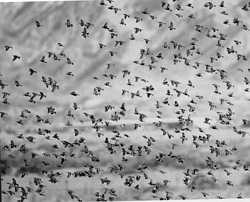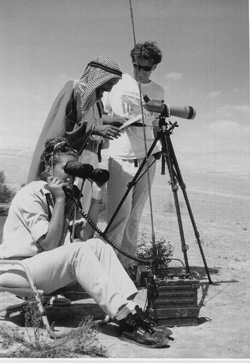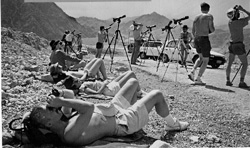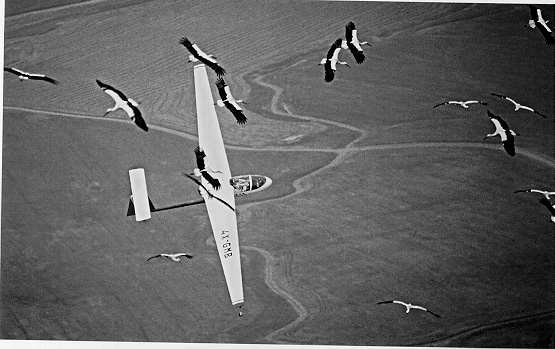By
Donald H. Harrison
San Diego (special) -- Ever since a dove brought back a piece of an
olive branch to Noah, birds have symbolized peace in the Middle East. An
exhibit scheduled through the month of August at San
Diego's downtown central
library tells how migratory birds which fly over Israel are providing
that country with new avenues for making friends.
 |
The exhibit, Migrating Birds Know No Boundaries, was
assembled by Dr. Yossi Leshem, former executive director of the Society
for the Preservation of Nature in Israel (SPNI) and now the founding director
of an international center in Latrun for the study of migratory birds.
Latrun is a village best known as the site of a tank warfare museum on
the road between Tel Aviv and Jerusalem.
In an interview from Israel, Leshem estimated 550 million birds cross
Israel twice a year, heading in March through May north to breeding grounds
in Europe and Asia and in August through November south to forage in Africa. |
Spanish sparrows over Eilat (photos
courtesy of
Society for the Preservation of Nature in Israel) |
Leshem said 280 species of birds are known to participate in the annual
migrations which follow fairly specific routes based on where thermal breezes
can help the birds to soar. Although it would be more direct for birds
flying from Africa to Europe to cross the Mediterranean, there are no such
helpful thermals for the birds to utilize over the sea.
 |
With so many species flying over the southern Negev, the
Mediterranean coast and the Arava valley, Israel has become a paradise
for birdwatchers and a good lure for tourism, according to Leshem.
The scientist said he personally has been captivated by the larger birds
which fly over Israel, among them pelicans, storks, and various kinds of
raptors including eagles, hawks and buzzards.
These are the species which caused the most concern to the Israeli Air
Force before Leshem earned his doctorate figuring out ways to chart the
bird migrations and enable the Air Force to avoid areas where the birds
will be flying.
"I established the whole project to follow migrating birds with |
Birdwatching brings people
together in a common pursuit |
a motorized glider, with radar, and with bird watchers," Leshem said.
"We made a network from the Mediterranean to the Jordan River."
"Because so many birds come over Israel, you cannot change them or move
them," Leshem said. So, "you can just learn when exactly they are coming
and leaving, what height are they flying and what route" and have the Air
Force avoid flying in the same air space.
As a result of such close observation of the birds' migratory patterns,
collisions between Israeli military planes and the large birds have been
reduced by 76 percent, according to the scientist.
 |
Such collisions are nearly always fatal for the birds,
and sometimes fatal for the pilots and crew of the aircraft. In the decade
between 1972 and 1982, according to Leshem "the Israeli Air Force lost
six aircraft and had 35 air collisions with damages above $1 million."
With the accident rate now less than one-fourth of those figures, "the
Israeli Air Force calculated that the program had saved them since 1984,
$450 million." |
| Birdwatching
safari in the Negev |
The scientist said the birds have been the cause of international cooperation
in a variety of spheres.
"We are now in a very exciting project where we attached radio transmitters
to storks," Leshem said. "There is a French satellite called the Argos,
and every 90 minutes we can follow the bird in real time.
"The story is that we have 77 storks which we are following through
the satellite and through the internet," Leshem said. "And now we have
more than 60 schools in Israel where kids can follow the birds in real
time."
 |
With a $1 million grant from the United States Agency
for International Development (USAID), parallel internet monitoring programs
are being set up in Jordan and the Palestinian Authority to enable their
school children to learn in tandem with Israeli students.
In the meantime, another project is bringing together children attending
Jewish schools in the United States and Israeli school children. |
|
Glider and storks over Israel |
"We developed a system last March to put a video camera into a nest of
lesser kestrels in jerusalem, and then you can see through the internet
real time pictures 24 hours a day," Leshem said. " This was a huge success
-- we have more than 150,000 people coming into our site, to watch the
lesser kestrel."
The web address for the Migrating Birds site is http://www.birds.org.il
In another international birdwatching development, "we had Charles Bronfman
visiting our project last month," Leshem said. He has got his program called
'Birthright' to bring all the Jewish kids to Israel. The idea is that we
will have five towns in the States where kids will be following peregrine
falcons which nest on the highest buildings.
"We have a pair in Seattle on the Mutual Tower. We have a pair in Boston,
a pair in Milwaukee, a pair in Montreal and we have a pair in Minneapolis,"
he said. "And the idea is that the Jewish communities will adopt the nests
in the States and each Israeli school will be connected to an American
Jewish school -- day school or a Sunday school."
The comparatively tame travelling exhibit was assembled 2 1/2 years
ago under the auspices of Israel's Foreign Ministry. A total of 11 versions
of the posterboard exhibit, in seven different languages, are now circulating
throughout the world.
For San Diego's central library, this is the second exhibit from Israel
in as many months. Earlier this summer, the Israeli Consulate-General in
Los Angeles arranged for an exhibit on historic maps of Jerusalem to be
shown at the library at 8th and E Streets downtown.
|

